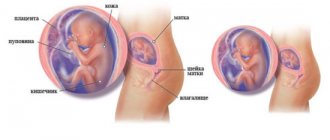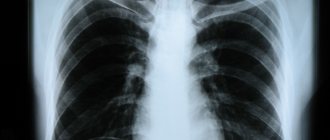Fluorography is a diagnostic procedure that is mandatory during preventive medical examinations. This method became widely used to detect chest diseases in the 1950s. The high incidence of tuberculosis in our country has made fluorography a necessary examination that must be completed before employment, admission to the hospital, and during professional medical examinations. Pregnant women are exempt from it. What to do if an examination is necessary or a woman finds out about pregnancy after having a fluorography?
Fluorography: principle of action, indications for research
Fluorography is x-ray photography of an image formed on a fluorescent screen, which is obtained when x-rays pass through a human being. When rays pass through, organs and tissues transmit them differently, which is displayed as light and dark areas in the photo. In this way, doctors can determine the presence of the disease and its location.
The most common is film X-ray photography, but in recent years it has begun to be replaced by digital. In digital photography, a CCD matrix is used instead of X-ray film. Another method of digital radiography is based on the principle of layer-by-layer scanning of the chest.
The main indication for fluorography is the detection of tuberculosis, cancer and other lung diseases. In addition, it allows you to detect infectious foci in the chest organs, changes in the heart, bones and muscles. Thanks to the penetrating ability of X-rays, it is possible to detect scars, cords, adhesions, sclerosis, and radiance of lung tissue. The image shows cysts, emphysematous phenomena, and infiltrates.
Doctors recommend being examined once a year for prevention and be sure to go to the X-ray room if you have had contact with a patient with tuberculosis. When living in unfavorable regions, it is allowed to take radio photography twice a year.
Fluorography at the pregnancy planning stage
Is it worth taking x-rays at the planning stage of a child? Future parents fear that radiation will affect the formation of germ cells. Their concerns are partly justified because ionizing radiation negatively affects growing and developing cells. Women should not visit the X-ray room in the first days of the cycle, when the oocyte is just forming in the follicle. Men should wait a few days after fluorography so that the sperm have time to renew themselves. The minimum period that must be waited before conceiving is 1 month.
However, you should not give up radio photography completely. It allows you to identify complex and severe illnesses that are best treated before pregnancy. Tuberculosis, pneumonia, lung tumors - these diseases can cause much more harm to the mother and unborn child than fluorography. If a married couple is worried about the effect of radiation on the germ cells, afraid that it will cause a chromosomal mutation and the child will be born sick, the diagnosis is carried out several months before the expected conception.
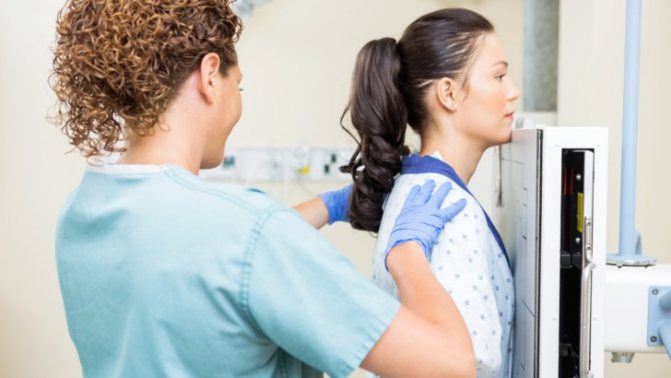
Possible risks
The question of whether pregnant women can undergo fluorography worries many women, since many of them, not knowing about their pregnancy, carried out this diagnosis. Indeed, if possible, it is better to refuse it so as not to harm the small organism. Previously, doctors even recommended abortion if fluorography was performed on pregnant women.

Today they are more loyal to this, based on the following:
- Radiography gives a dose of radiation exposure no higher than the level of air radiation in an industrial city.
- Modern devices are less dangerous than older models; the possibility of exposure to radiation is minimized.
- The examination is carried out not on the pelvic area, but on the chest, and the rays do not have a direct effect on the embryo.
- A pregnant woman protects her internal organs with a special apron during the procedure.
Danger to the fetus
A situation often arises when a woman has undergone fluorography without knowing that she is pregnant. In the first weeks of pregnancy, the use of this diagnostic method does not pose a risk to the development of the child, since the egg fertilized by sperm has not had time to reach the uterus and attach to it.
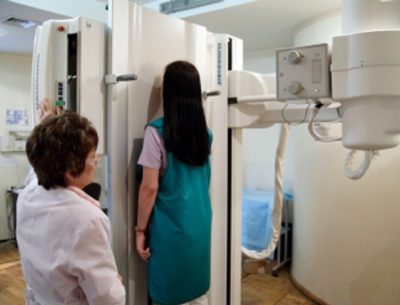
Why fluorography cannot be done later can be explained by the fact that the risk of complications increases in the period from 2 to 20 weeks, since at this time the likelihood of miscarriage increases.
Is it possible to do fluorography at an early stage? This time is also a period of rapid cell division and can lead to the formation of pathologies at the genetic level, increasing the risk of developing tumor conditions, developmental and growth delays.
When cells divide, they become susceptible to the influence of external factors, including this examination. When asked what period is safer for the procedure, doctors say that in the second half of pregnancy the risk of developing pathologies decreases.
Most often, fluorography during pregnancy does not harm the fetus if, in addition to it, the baby has not had other negative influences, which include stress, smoking, drinking alcoholic beverages, and poor nutrition. When several negative factors are combined, the following consequences occur:
- a miscarriage is possible, the woman may not even know about her pregnancy, normal menstruation will pass;
- a child may be born with minor pathologies that do not affect his life in any way;
- Genetic defects may develop that worsen the child’s quality of life.
When planning a pregnancy, many parents often undergo a full examination in order to give birth to a healthy baby. At this stage, questions often arise as to whether fluorography will be harmful when planning a pregnancy and how many days later you can become pregnant.
Typically, women planning to conceive are advised to have the test done immediately after their period, when there is less chance of getting pregnant. Pregnancy that occurs after fluorography, as a rule, is not burdened by anamnesis.
Fluorography for the future father
A man can undergo an examination at any time before conceiving a child, but in order to exclude a negative effect on the condition of sperm and for self-soothing, he should wait a few days. After fluorography, you can start conceiving in a couple of days; this time is needed for sperm renewal.
Important Hormonal drops for the runny nose: list of medications for the nose, names of drugs approved for children, review of reviews of treatment

Unfortunately, today such a disease as tuberculosis is often encountered, and it is characteristic not only of antisocial families. The easiest way to identify this dangerous disease is x-ray examination. As you know, a newborn is most susceptible to the negative effects of bacteria, since he has no immunity to them.
Fluorography of a husband during his wife’s pregnancy will help protect the expectant mother and baby from possible risks. Naturally, medical workers will not force you to do this examination. The husband has the right to refuse it, while writing the necessary statement. However, giving birth to a child requires responsibility, sometimes it is better to play it safe and undergo this examination than to regret it later.
How can fluorography affect pregnancy if done early?
Why is X-ray photography harmful in early pregnancy? In the first weeks of gestation, the active formation of organ rudiments in the embryo occurs. From a zygote - a single-celled embryo - a blastocyst consisting of several cells is produced by division. The cells of the embryo begin to specialize and continue to divide, thus forming primary tissues from which the rudiments of organs are formed. By mid-term, the fetus has already formed most of its organs.
Young dividing cells are most susceptible to the negative effects of ionizing radiation. This is why many doctors are categorically against X-ray photography of pregnant women. They believe that such exposure can lead to an abnormal pregnancy. It is recommended to refrain from chest examination until 25 weeks. In the second half of pregnancy, radiation will not harm the fetus.
How justified are these warnings? Some doctors question such fears. They are confident that it is possible to have a pregnant woman undergo fluorography once; it will not harm the child, because in medical practice there is not a single case recorded when radiophotography would lead to disruption of the baby’s intrauterine development. In addition, during the procedure, the woman’s stomach is covered with a lead apron, through which X-rays do not pass.
Possible consequences for the child in the early and late stages
X-rays in the early stages of pregnancy - before the menstrual cycle is delayed (in the first days) and at a period of two weeks can cause
- placental abruption;
- pregnancy fading;
- spontaneous abortion.
X-ray photography, which is taken starting from the second week of gestation, can cause:
- genetic pathologies;
- developmental defects;
- developmental deviations.
Negative consequences for a child after fluorography may be absent and can be corrected due to their insignificance.
Over a long period of time, irradiation is less dangerous (starting from the 21st week of gestation) - the fetal organs are formed and there are no complications in the form of cellular mutations.
What to do if a pregnant woman is about to undergo or has already undergone fluorography?
In cases where a doctor recommends examination during pregnancy and argues for its importance, you need to listen and do screening. If a woman has undergone fluorography without knowing about pregnancy, she will need to inform the gynecologist about this
The doctor will decide whether or not to take additional measures to prevent the child from developing abnormalities.
To prevent the health of a pregnant woman and fetus, the following recommendations can be given:
- undergo screenings that determine the presence of intrauterine pathologies;
- monitor your health and avoid the influence of stress and other unfavorable factors;
- control nutrition and exercise;
- give up dangerous habits.
Fluorography affects the development of the fetus in the early stages of pregnancy, but it is undesirable to refuse to perform the procedure when it is needed. The unborn baby and his mother will suffer more when the pathology is detected late and they have to take huge doses of strong medications. Studying the reviews of women who have already given birth about the procedure, the following conclusion is made: once the radiation received does not affect the baby.
One of the specialists tells what a pregnant woman should do after an early pregnancy X-ray. Taken from the Moscow Doctor clinic channel.
When fluorography cannot be avoided
There are times when it is necessary to do an examination without waiting for labor to occur.
These include:
A pregnant woman is in constant contact with a person diagnosed with tuberculosis. The contact is not even constant, but close
It is important to tell the gynecologist, and he will decide and explain why and what kind of test you will need to take. Do not take x-rays yourself. Someone from the future mother's family - husband, child (or living within the apartment) - is the owner of a Koch wand
Carrier status is confirmed by an appropriate test reaction. A pregnant woman is suspected of having cancer. Especially when the cancer affects the respiratory system and heart, its location needs to be known before she goes to give birth. Suspicion of pneumonia. When a foreign object enters the upper respiratory tract.
Doctors' opinion
Doctors have an ambiguous attitude towards the issue of radiography. Some competent specialists are inclined to believe that X-rays are necessary for serious indications. Gynecologists often talk about the minimal risk of developing abnormalities in the fetus, since the rays do not descend to the bottom of the uterus.
Important Lozenges for sore throat: cheap and effective, for children, adults, during pregnancy
Other doctors are inclined to avoid X-ray examinations, justifying their opinion by the fact that rays enter the body
The place of their penetration is not important, which justifies the danger of mutations. Therefore, any irradiation procedure should be prohibited throughout pregnancy.
Loading …
What to do if the study was carried out when the woman did not know that she was pregnant?
Not all women know about pregnancy from the first weeks. With an irregular cycle, when a delay is common, and small bleeding that the expectant mother may mistake for menstruation, the woman may not even suspect that she is pregnant. At this time, she can undergo a medical examination and undergo a routine examination, including radio photography.
If fluorography was done before the expectant mother found out about pregnancy, she should immediately consult a doctor. After listening to an explanation of the situation, the doctor will decide whether to prescribe additional diagnostics, ultrasound or genetic analysis. Women over 35 years of age, as well as those with relatives with chromosomal abnormalities, are at risk. The risk of pathologies in a child may increase under the influence of radiation.
What you definitely shouldn’t do is worry too much. Stress has a much worse effect on the course of gestation than a single dose of ionizing radiation.
About radiation and pregnancy
Hello, dear Evgeniy Olegovich.
I don’t dare hope (however, I really want) that you will remember me, but, nevertheless, now, when I am standing at a crossroads, thinking about who else I will turn to, the memory of you popped up in my head like a saving thread. Well, to make it more clear, I’ll start in order. 5 and a half years ago I gave birth to a daughter. My mother bought me your book The Beginning of Your Child’s Life. It’s not enough to say that I WAS indescribably delighted with it; I still re-read it from time to time, just to recharge myself with good emotions. And how many children grew up with it? I take care of her like the apple of my eye. When my daughter was about 5 months old, I finally made up my mind and wrote to you. And what was doubly pleasant was that you ANSWERED me. Reasonable and thorough, and even gave contact numbers. But since there were no special problems with the child, I did not consider it necessary to take you away from work or household chores. I just wrote you another letter with words of gratitude. But, probably, our mail (ordinary mail) did not deliver it to you. And, nevertheless, I want to thank you again for your work and your attention. Thank you very much, and may God grant you health, as well as strength and patience for your difficult, but so necessary work. And this is what prompted me to turn to you now. Life turned out in such a way that I left my first husband and have been in my second marriage for more than 2 years. We love each other very much. And my husband, naturally, really wants a child (he madly loves my daughter; I have never seen a more caring, patient, loving father, neither in my first marriage, nor in the families of friends and acquaintances), but due to various circumstances (figure, career, social life), I was afraid and kept putting it off. Finally we made up our minds. After all, I’m not getting any younger, and getting serious about my career means postponing the birth of a child indefinitely, or even forever. We approached this very thoroughly. We were examined by doctors. Both are healthy. I have never had gynecological diseases, and no. The doctors unanimously said forward. And then... I broke my ankle. I had to take an x-ray. There have been no delays as such (1 day). The test showed a negative result. The traumatologist sent me for surgery. I refused the operation, and then I was sent to various consultations and in the end I had to take another x-ray. I said that I might be pregnant. I was carefully covered (just like the first time). In the end, it turned out that at this stage the operation is not vital, but in any case it is necessary to contact a gynecologist. The second test gave a positive result. Because I myself can’t really walk right now (I can’t go to the antenatal clinic on crutches), my mother went... If only you could hear in what form and in what words the words of the local gynecologist were conveyed to me. Well, in a nutshell, up to 18 days of vacuum, then abortion. You'll think it's no big deal, then he'll take it out. I also had to listen to a lecture about my own stupidity. And even by phone. What came out of this was almost a nervous breakdown. I called my husband, I couldn’t say a word, he quit work, rushed over, and spent the whole day running around with me like a child. Then all friends and acquaintances began calling all imaginable and inconceivable acquaintances through familiar radiologists, traumatologists, and gynecologists. Everyone unanimously says don’t be foolish (sorry for the unliterary style, but, as they say, you can’t erase words from a song), it’s okay to bear and give birth, with our ecology we receive so many negative factors and emotions every day that this can’t possibly happen will affect the child. That is, it can, of course, but not to such an extent as to take radical measures. Radiologists even give chilling examples that before, when there was no ultrasound, they did an X-ray of the fetus, and they gave birth to nothing. I really, really want to believe this. Friends advised me (my head is no longer thinking well) to look on the Internet to see if there was any information on my question, I found some sites that gave answers to questions similar to my problem, but they were very ambiguous. And suddenly inspiration! Remembering you, I found your website (simply super!!!) and address online and decided to try my luck again. I value and trust your opinion very much, and I will be very grateful if you take the time to answer. Today is 14 days late. The very word abortion fills me with wild horror. What about the vacuum? DON'T WANT!!! But if you still have to, then the deadlines are running out.
Please help me.
I hope very much for your help. Thank you in advance, best regards, Julia. published 01/21/2009 18:44 updated 12/18/2016 — Correspondence
Is fluorography prescribed for pregnant women, in what cases and how is it performed?
Pregnant women are not routinely sent for fluorography, even if it is necessary during a medical examination for the workplace. However, this diagnosis cannot be avoided if there are suspicions of diseases of the chest organs.
X-ray photography is done only for vital indications, when the harm from the lack of correct diagnosis and treatment is much higher than from X-rays. Indications:
- pulmonary tuberculosis in a pregnant woman or her loved one with whom she has been in contact;
- pneumonia;
- neoplasms in the lungs;
- enlarged heart;
- entry of a foreign body into the lower respiratory tract.
When choosing between irradiation methods, you should choose digital fluorography, which is performed using a scanner method. During the procedure, the chest is scanned layer by layer in the horizontal plane with a fan-shaped beam of X-rays. Unfortunately, not all hospitals have new equipment; most have old film machines.
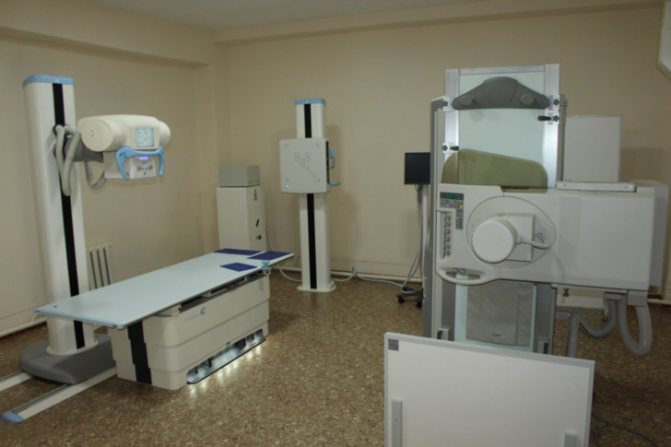
The table shows a comparison of two X-ray photography methods:
| Diagnostic method | Radiation dose | Percentage of permissible annual radiation dose |
| Film | 0.5–0.8 mSv | 50–80% |
| Digital | 0.05 mSv | 5% |
The doctor giving the referral for the examination and the nurse performing the procedures must know that the patient is pregnant. During the irradiation process, the woman's abdomen and pelvis will be covered with a lead apron.
Is it possible to replace radiophotography with other diagnostic methods? Depending on the disease, the doctor may prescribe other examinations:
- Ultrasound. Ultrasound will not help detect tuberculosis or pneumonia, but it is effective in detecting changes in the heart muscle.
- Blood chemistry. Allows you to identify infectious and inflammatory diseases and suspect the presence of tumors.
- PCR swab. For diseases of the lungs and bronchi, sputum is examined. This analysis allows you to detect a specific pathogen.

How to minimize radiation
Technological progress does not stand still, so modern fluorography devices are equipped with all kinds of devices, thanks to which:
- the level of radiation is reduced;
- targeted irradiation of the chest occurs without affecting other parts of the body.

To protect the abdominal cavity and pelvic organs, a pregnant woman should ask for a special apron
All this reduces the risk of examination to a minimum. However, fluorography during pregnancy is carried out only according to a doctor’s indications and under the supervision of a qualified specialist. A woman may request an additional apron to protect her abdominal and pelvic organs.
Digital fluorography is safer than film fluorography, so pregnant women are recommended to undergo examination on a digital device
With x-rays, the level of radiation is slightly lower than with film fluorography, so if it is not possible to be examined using a digital device, then discuss with your doctor the possibility of prescribing an x-ray.
If fluorography was carried out before the woman found out about her pregnancy, then at 12 weeks an in-depth ultrasound examination is carried out, which will show whether there are any abnormalities in the development of the embryo. In addition to an ultrasound, the expectant mother can come for a consultation with a geneticist, who will correctly assess the risks and give the necessary recommendations.
What is more dangerous – x-ray or fluorography?
Another diagnostic method that uses x-rays is a chest x-ray. How does it differ from fluorography?
Features of radiography:
- Allows you to identify those ailments that are not visible on a fluorogram. X-rays are necessary for suspected pathologies of the cardiovascular system, injuries and bone diseases.
- Detects smaller formations. The minimum lesion visible on fluorogram has a diameter of 5 mm. X-ray is capable of recognizing neoplasms and lesions with a diameter of 2 mm. This is very important for the early diagnosis of tuberculosis and lung cancer.
- The costs of producing an image are higher. To obtain a fluorogram, the film can be developed directly in rolls; less of it is required, which makes the diagnostic method cheaper. X-rays are developed using special baths, so x-rays take longer to take and are more expensive.
- The dose of ionizing radiation is higher. X-rays are prescribed only if serious pathologies are suspected, because the radiation dose is 2 times higher. This is necessary to ensure greater penetration of X-rays through organ tissue.
So should pregnant women refuse fluorography or not? If a preventive examination can be postponed, then the diagnosis prescribed by the doctor cannot be refused. Radiography allows early detection of diseases that, without treatment, can lead to serious consequences.






